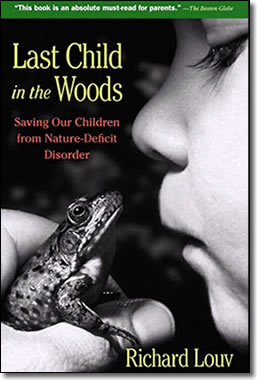Go Play Outside
by Keely Carroll, Executive Editor
Instructor, Biological Sciences Dept., Sierra College
I was having a conversation with my Papa recently about baseball. Having been the coach of a local High School team for over 30 years he has coached several generations of the same family during that time. He loves the game of baseball. He doesn’t really love to watch it on TV, sure, he might have the game on in the background as he is working on other tasks, but he doesn’t really watch games. He loves the strategy of it, he loves the history of it and he loves teaching it to his players. I would have thought that someone like him would have played organized baseball his whole life but he hadn’t. He commented that he didn’t start playing Little League until he was 11. I was shocked, in today’s organized sports arena, 11 would be a bit old to take up the game. I suggested as much to him and he replied that it didn’t mean that he didn’t play the game until he was 11, he just didn’t do Little League until he was that age.

That got me thinking. As a parent of two children, ages 9 and 6, I live in the world of organized sports. As I write this, I even have to have one child at a baseball game at the same time that the other child has to be at swim practice. My son has played organized basketball and soccer and my daughter is into swimming and horseback riding.
Then and now
I am sure that for many of us we can look back on our own childhoods and remember the organized sports teams of our youth but its different than today. I think that the difference is that that we also played those sports away from those city or privately organized teams: we played pick-up games in the street or at the park. Did you ever play baseball and have the neighbors’ car act as first base? Did you ever play capture the flag in an overgrown park? Did your parents ever drop you off at the local creek to catch pollywogs and then you rode your bike home? Perhaps your experiences are a bit different but I think that the theme is the same: we were outside.
The generation before mine (I am a gen Xer) spent quite a lot of time outside. There was no thought given to whether or not you would play outside. Sure there was television but it was more of a family oriented activity. No one used the TV as a babysitter back then. Children, left to their own devices, and free of daily chores, would play pick-up games, climb trees and build forts. Growing up my mom was fine with me biking across town to go swim. She was fine with me climbing trees (I was the fastest on the block). She never thought twice about me playing in a park with loads of overgrowth. I played some organized sports but I also built those forts and collected those pollywogs too.
Kids at play?
Now maybe I am just not driving in the right neighborhoods but I have never turned a corner and seen kids running out of the street with their gloves and bat to get out of the way of my car. Sure, I have seen kids outside on occasion but usually close to the house, sometimes even behind a driveway sign that says “Caution: Kids at Play” but I never really see kids out and about. The children of this generation are more likely to play video games or watch TV than play outside.

Many children and even some young adults select the artificial reality of the video game world over the real world itself. According to the website www.gamepro.com Madden NFL 11 was the number one selling video game through August 2010 and Wii Fit Plus was number 10 during the same time period. While I admit that most of us aren’t going to be professional football players but I am pretty sure that of those millions of people playing Madden Football at home that very few are actually playing the game in real life. What about spending almost $90.00 to buy the Wii Fit Game along with the balance board, when a walk or a run outside will burn calories just as efficiently.
Bogeyman syndrome

Why aren’t we outside as much anymore? And why has there been such a rise of organized sports in the past few years? Richard Louv, author of Last Child in the Woods suggests that parents have developed what he calls the “bogeyman syndrome” about the world outside.
A Mayo Clinic survey conducted in 1998 of parents stated that of those surveyed three-quarters of them feared that their child would be abducted and one-third of those parents said that they worried about abduction more than any other typical concern that a parent might have. Parents fear the random stranger that might drive down their street and take their children but in actuality most child abductions are done by people from that child’s own family. An article from the January 17, 2007 issue of Slate at http://www.slate.com/id/2157738/ states that when you break down the numbers of reported child abductions reported during 2001, of which there were about 800,000, 115 were the type of abductions that parents fear the most: stranger abduction.
Pollution outdoors and indoors

Perhaps it is just that the outdoors are more inherently dangerous compared to the indoors. In actuality, according to the Environmental Protection Agency, indoor air pollution in some areas may be worse than outdoor air. From the formaldehyde found in some carpets to indoor molds and smoke, whether secondhand or from a fireplace, the indoor environment can be much worse than the outdoors. Also, stop for a moment and think about what we do when we are inside. Most of us turn to the television and video games. Some of us even snack while we do these activities. That lack of movement and consumption of those snack foods, I would argue, is much more dangerous for the health of a child than a walk in the woods.
Why do parents seem to fear that which is so unlikely? I would suggest that part of it is because we live in the 24-hour news cycle, where opinion can become news and rare occurrences can become blown up into major issues. In the summer of 2001 news of shark attacks on swimmers became the overblown news story of that season. News reports seemed to come almost daily that yet another swimmer had been attacked. People grew fearful of the water, yet the number of shark attacks that year were not appreciably higher than in previous years. Stories of child abduction, or mudslides, or of west Nile virus get embellished and replayed on the news until we come to believe that these risks are everywhere.
Is organized safer?
It seems today that the compromise that parents have arrived at is organized activities. Organized sports. Organized playdates. Organized indoor play sessions. Parents have slipped into this notion that organized activities are better for our children; that they are somehow safer, yet climbing a play structure at an indoor facility can be just as risky as climbing a real tree. My son broke his femur when he was 4 not while jumping over rocks outside but when he caught it on a piece of play equipment at an indoor play facility. While nice to use on a rainy day, organized play facilities constrain imagination when they force children to play following a particular script.
Suppose you do let your child play outside. Unfortunately there are constraints even then. Parents prefer parks to be well groomed so that they can see their kids at all times so there are no forts built in the overgrowth. Play equipment must be labeled so parents can know the appropriate ages that children should be to play on those structures. Children can’t build forts in parks or neighborhoods because they look “unattractive” or they “harm nature”. Children can’t climb trees because of liability issues. Sometimes it seems as though the days of free play are gone.
If I sound like I am mourning those days, you would be correct. But what difference does it make, really, if a child plays outside or not? What do you get from being outside? Exercise to start with. Kids who play outside can be more fit than their indoor bound counterparts, possibly lowering the incidence of obesity. A greater amount of exercise increases coordination and helps kids to sleep better at night because they are tired from a day of play.
Nature deficit disorder
Richard Louv calls the disconnect that children have from nature today “nature deficit disorder”. He suggests that this condition may actually be contributing to the higher rates of ADHD that we are seeing in children today. The increased time spent outside may reduce the need to medicate these children.
A connection to nature may also foster kindness. Children learn about their role in the environment when they play outside. They learn that if they don’t return that pollywog to the creek, that it may die. They learn a certain amount of stewardship from that experience and may treat things and people with a greater amount of respect.
A connection to nature teaches children that overconsumption has a negative effect on the environment. They see that the trash that people throw out winds up, very often, in the fields and creeks they play in and by. They realize that the natural resources used to make those toys they want so badly come from the places they like to play. This connection may help them to better realize the difference between what they want and what they need.
A connection to nature gives children perspective. They can see a tree on TV or they can go outside and touch one, smell one when they do. That tree becomes more real and more important when they have made that connection. That connection will encourage children to care for that tree and for nature in the greater sense. Let us not forget that children are the future stewards of the environment. They will care for the earth and us when we are old and they will pave the way for the way that next generation perceives nature. When children have perspective they will care and that will make all of the difference in the world.
